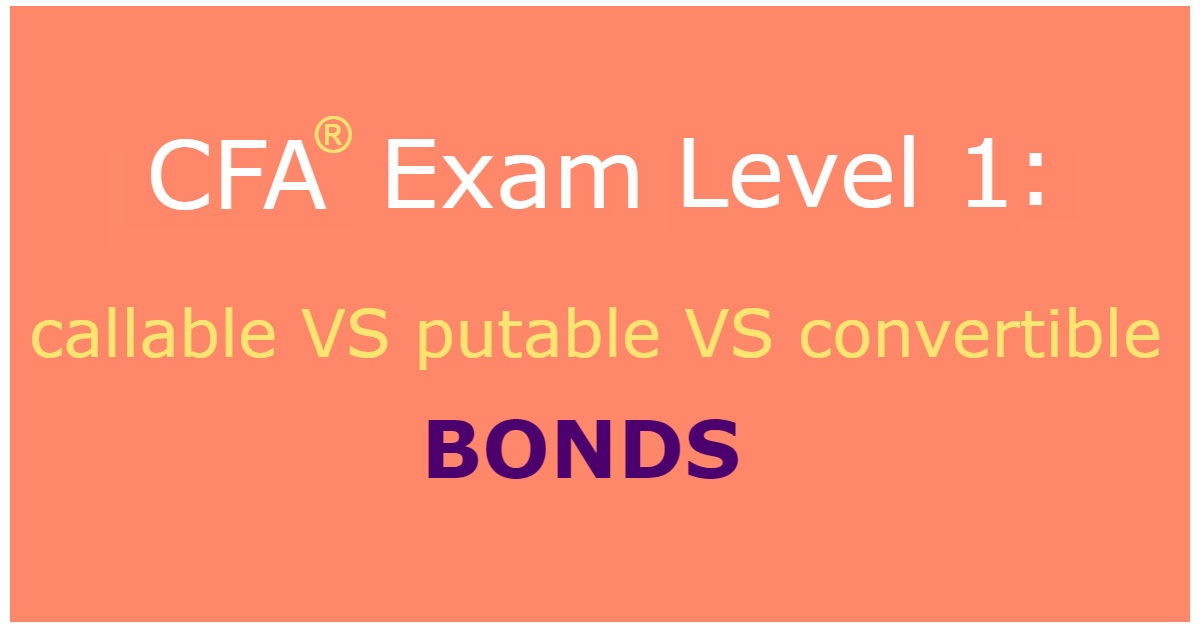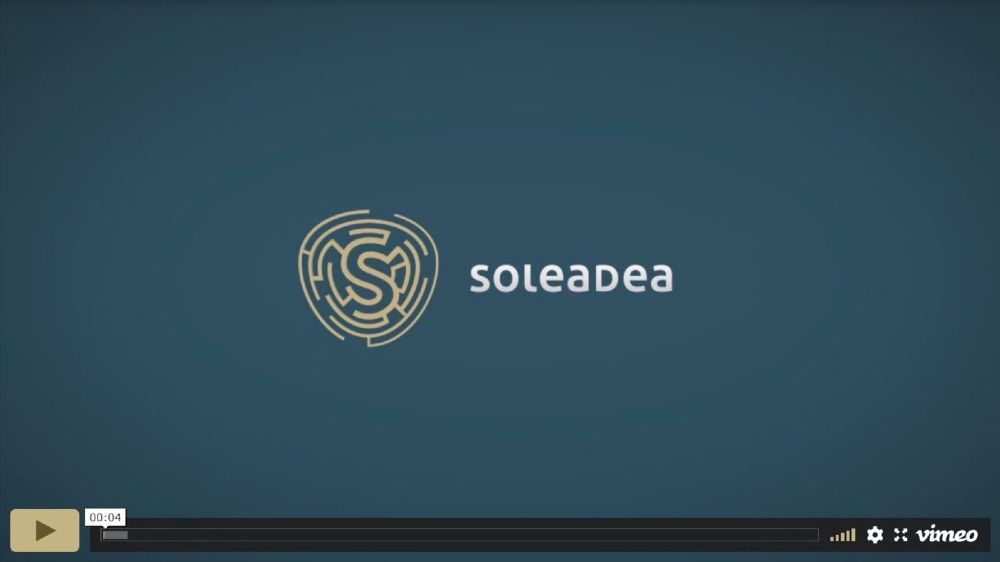Level 1 CFA® Exam:
Callable bond vs Putable bond vs Convertible bond

There are 3 types of options that can be embedded in bonds: call options, put options, and conversion options. Therefore, we distinguish 3 types of bonds with embedded options: callable bonds, putable bonds, and convertible bonds, respectively. The value of an option influences the value of the bond.
Defining an Option
An option is a derivative instrument, which means that its value depends on the value of some underlying asset. The underlying asset can be a stock, a market index, an interest rate and so on. If an option is embedded in a bond, the value of the option depends on the price of the bond, which means that it depends on interest rates.
An option gives one party a right to buy or sell an underlying asset in the future and the other party – an obligation to sell or buy the underlying asset in the future. This means that the latter party is obligated to sell or buy the underlying in the future if the former party requests it. If the option holder decides to use his right, we say that he exercises the option.
Call Option vs Put Option
Depending on whether an option involves a right to buy or a right to sell the underlying, we distinguish two types of options:
- a call option, and
- a put option.
A call option gives the option buyer a right to buy an underlying asset in the future at a specified price from the option seller. In other words, the option seller is obliged to sell the underlying on the buyer's request.
A put option gives the option buyer a right to sell an underlying asset in the future at a specified price to the seller of the option. The seller of a put option is obliged to buy the underlying on the option buyer's request.
In the case of bonds, a put option is the right of the bondholder to sell back the bond to the issuer and the call option is the right of the issuer to buy back the bond from the bondholder.
An embedded option usually has some value. So, if an option is embedded in a bond, it affects both the bond’s value and the required yield. Note, that a put option and a conversion option are beneficial to the bondholder, and a call option is beneficial to the issuer.
So, a call option granted to the issuer results in a lower price of the bond. The bondholder is willing to pay less for the callable bond and requires a higher rate of return:
the value of the callable bond = the value of the bond without an embedded option – the value of the call option
If an option is granted to the bondholder, like in the case of a put option or a conversion option, he values the bond with the embedded option more and so is willing to pay a higher price for the bond. It also means that he requires a lower rate of return.
the value of the bond with an embedded option beneficial to the bondholder = the value of the bond without an embedded option + the value of the option
The price of a callable bond equals USD 950, and the price of the same bond but without an embedded call option is equal to USD 970. What is the value of the call option?
USD 950 = USD 970 – value of the call option
value of a call option = USD 970 – USD 950 = USD 20
The current price of a bond with an embedded option is equal to USD 840. The price of the same bond without an embedded option is equal to USD 920. Is the option beneficial to the bondholder or to the issuer?
(...)
The yield to maturity for a bond with an embedded option is equal to 10%. The YTM for the same bond without an embedded option is equal to 11%. Is the option beneficial to the bondholder or to the issuer?
(...)
Volatility of Underlying Asset
The value of an option changes when some characteristics of the underlying asset change. One such a characteristic is the volatility of the underlying asset. The rule is as follows: if the volatility of the underlying asset increases, the value of both the call and put option also increases, and vice versa. If the volatility of the underlying asset decreases, the value of both the call and put option also decreases. In the case of options embedded in bonds, the volatility of interest rates is the volatility that affects the value of options. Let us look at the following example.
The price of a bond with an embedded call option was equal to USD 876. As a result of the change in volatility of the market discount rate, the price of the bond decreased. Decide whether the volatility of the market discount rate decreased or increased.
We know that the embedded option is the call option. We also know that as a result of the change in volatility of the market discount rate, the price of the bond decreased.
First we have to answer the following question:
Since we are dealing with a callable bond, what will cause a decrease in the bond price: an increase or a decrease in the call option’s value?
Recall that the value of the callable bond equals the value of the bond without an embedded option minus the value of the call option. Thus, an increase in the value of the call option will lead to the callable bond price decrease.
Knowing that, we can now answer the question that goes as follows:
What will cause the call option value increase: an increase or a decrease in volatility?
According to what we said in the introduction to this example, an increase in volatility of the market discount rate leads to an increase of both the call and put option value. So, in the case of example 4 the volatility of interest rates must have increased.
| call value | increases | callable bond value decreases & yield to maturity increases |
|---|---|---|
| call value | decreases | callable bond value increases & YTM decreases |
| put value | increases | putable bond value increases & YTM decreases |
| put value | decreases | putable bond value decreases & YTM increases |
| volatility of interest rate | increases | call value & put value increase |
| volatility of interest rate | decreases | call value & put value decrease |
Let’s now say a little bit more about putable and callable bonds.
Generally, there are three exercise styles of options:
- American style,
- Bermuda style, and
- European style.
American call and American put can be exercised anytime between the first call date or the first put date, respectively, and the bond maturity date. Bermuda-style options can be exercised only on given dates. Finally, European style options can be exercised only on one given date.
You should know that all characteristics of an option, such as its exercise price, lockup period, exercise style and so on, are given in the bond indenture.
In the exam, you should also remember under what conditions the party will most probably want to exercise the option. In the case of a put option, the bondholder will be eager to exercise the option if interest rates increase and the bond price decreases. In the case of a call option, the issuer will be willing to exercise the option if interest rates decrease and the bond price increases.
Sometimes there is also a conversion option embedded in the bond.
The bondholder of a bond with a conversion provision can exchange the bond for a specified number of ordinary shares issued by the issuer. A conversion option is beneficial to the bondholder (exception: CoCos) because it gives him a right and not an obligation to exchange the bond for the shares.
The terms related to convertible bonds that you should know include:
- the conversion price,
- the conversion ratio,
- the conversion value,
- the conversion premium, and
- the conversion parity.
We have a convertible bond issued by Black Dots, Co. with the current price equal to USD 950 and the par value of USD 1000. The bond can be converted into 25 shares of the company. The current share price is USD 37.
(...)
Now let’s consider when bondholders will be interested in converting bonds into shares.
The higher the share price, the more the bondholder is likely to convert bonds into shares. Have a look at the following example.
We have a USD 1000 par value convertible bond for which the current price is equal to USD 980 and the conversion price is equal to USD 50.
Scenario 1: What is the conversion value if the share price equals USD 48?
Scenario 2: What is the conversion value if the share price equals USD 53?
(...)
The greater the share price, the greater the conversion value, and the greater the value of the conversion option.
We should also mention the so-called CoCos here. These are also convertible bonds, but they are characterized by some special features. First of all, they convert automatically when a certain pre-specified condition occurs. What is more, they convert when the share price is decreasing, and not increasing. For these reasons, CoCos are NOT beneficial for bondholders and their price is lower than the price of the same bond without an embedded option.
Level 1 CFA Exam Takeaways for Callable, Putable, and Convertible Bonds
star content check off when done- There are 3 types of options that can be embedded in bonds: call options, put options, and conversion options.
- A call option gives the option buyer a right to buy an underlying asset in the future at a specified price from the option seller.
- A put option gives the option buyer a right to sell an underlying asset in the future at a specified price to the seller of the option.
- The bondholder of a bond with a conversion provision can exchange the bond for a specified number of ordinary shares issued by the issuer.
- In the case of a put option, the bondholder will be eager to exercise the option if interest rates increase and the bond price decreases. In the case of a call option, the issuer will be willing to exercise the option if interest rates decrease and the bond price increases.
- Options usually have some values and these values affect bond prices. If the option is beneficial to the bondholder, we add the value of the option to the price of the option-free bond (aka. straight bond), and if the option is beneficial to the issuer, we subtract the value of the option from the price of the option-free bond.
- If the call value increases, the callable bond value decreases and YTM increases. If the put value increases, the putable bond value also increases and YTM decreases.
- If the volatility of the market discount rate increases, both the call value and the put value also increase.
- There are 3 exercise styles of options: American style, Bermuda style, and European style.


